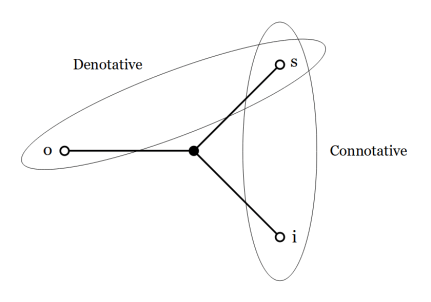Re: Peirce List • Jon Awbrey • John Collier
- JA:
- Questions about the meaning of the “central hub” in the “three‑spoked” picture of an elementary sign relation have often come up. The central “spot”, as Peirce called it in his logical graphs, is located on a different logical plane, since it is really a place‑holder for the whole sign relation or possibly for the individual triple. Normally I would have labeled it with a letter to indicate the whole sign relation, say
or else the individual triple, say
- JC:
- I strongly agree, Jon. Reading meaning into artefacts of the representation is not typically transparent. I would say that the whole symbol represents the sign with its threefold character and that the node is not some separate signifier. To put it on this level is, as you suggest, a category error.
Precisely. And “artefact” is a very choice word here, with all the right connotations. It would be unfortunate if this trivial “triskelion” figure became a caltrop to our thought, blocking the way of inquiry.
Aside from the ellipses we added to call attention to a couple of derivative dyadic relations, somewhat loosely called denotative and connotative in our paper, it is merely typical of the 3‑spoke figures in common use when I was first learning Peirce’s theory of signs, often arising to point out the differences between Saussure’s dyadic semiology and Peirce’s triadic semiotics.
The intervening decades have taught me all the ways diagrams and figures of that sort can be misinterpreted when the conventions of interpretation needed to understand them are not up and running. It can be instructive to carry out post mortems on the various maps of misreading but if one is not up for the morbidity of that, it is probably wiser to move on to more viable representations.
References
- Awbrey, S.M., and Awbrey, J.L. (2001), “Conceptual Barriers to Creating Integrative Universities”, Organization : The Interdisciplinary Journal of Organization, Theory, and Society 8(2), Sage Publications, London, UK, 269–284. Abstract. Online.
- Awbrey, S.M., and Awbrey, J.L. (September 1999), “Organizations of Learning or Learning Organizations : The Challenge of Creating Integrative Universities for the Next Century”, Second International Conference of the Journal ‘Organization’, Re‑Organizing Knowledge, Trans‑Forming Institutions : Knowing, Knowledge, and the University in the 21st Century, University of Massachusetts, Amherst, MA. Online.
- Awbrey, J.L., and Awbrey, S.M. (1995), “Interpretation as Action : The Risk of Inquiry”, Inquiry : Critical Thinking Across the Disciplines 15(1), 40–52. Archive. Journal. Online (doc) (pdf).
cc: Conceptual Graphs • Cybernetics • Structural Modeling • Systems Science
cc: FB | Semeiotics • Mathstodon • Laws of Form • Academia.edu


Pingback: Survey of Semiotics, Semiosis, Sign Relations • 4 | Inquiry Into Inquiry
Pingback: Survey of Semiotics, Semiosis, Sign Relations • 5 | Inquiry Into Inquiry